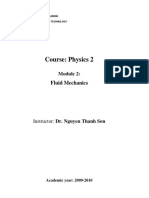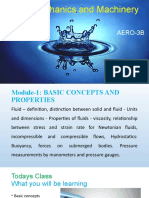Hidrolika I (IL-2101) Slide 2
Hidrolika I (IL-2101) Slide 2
Uploaded by
Afriana Maharani PuteriCopyright:
Available Formats
Hidrolika I (IL-2101) Slide 2
Hidrolika I (IL-2101) Slide 2
Uploaded by
Afriana Maharani PuteriOriginal Description:
Copyright
Available Formats
Share this document
Did you find this document useful?
Is this content inappropriate?
Copyright:
Available Formats
Hidrolika I (IL-2101) Slide 2
Hidrolika I (IL-2101) Slide 2
Uploaded by
Afriana Maharani PuteriCopyright:
Available Formats
INTRODUCTION TO
FLUID MECHANICS
Benno Rahardyan
Marisa Handajani
Haryo Satrio Tomo
Fluids Properties
Fluids vs. solids
Density
Compresibilty
Viscosity
Surface Tension
Pressure
Motivasi
Pola, Perilaku, Interaksi
?
Definition of a Fluid
A fluid is a substance that flows under the action of shearing
forces. If a fluid is at rest, we know that the forces on it are in
balance.
A gas is a fluid that is easily compressed. It fills any vessel in
which it is contained.
A liquid is a fluid which is hard to compress. A given mass of
liquid will occupy a fixed volume, irrespective of the size of
the container.
A free surface is formed as a boundary between a liquid and a
gas above it.
Shear : A force acting in a direction parallel to a surface or to a
planar cross section of a body.
Density
The density of a fluid is defined as its mass per unit
volume. It is denoted by the Greek symbol, .
=
V
m
3
kgm
-3
If the density is constant (most liquids), the flow is
incompressible.
If the density varies significantly (eg some gas
flows), the flow is compressible.
(Although gases are easy to compress, the flow may be treated as
incompressible if there are no large pressure fluctuations)
water
= 998 kgm
-3
air
=1.2kgm
-3
kg
m
Exercise 1
The specific weight of water at ordinary pressure and
temperature is 9.81 kN/m3. The specific gravity of mercury
is 13.56. Compute the density of water and specific weight
and density of mercury
Compressibility
Compressibility :
change in volume due
to change in pressure
For liquid is a function
of P, T
Liquid compressibility
is inversely
proportional to its
volume modulus of
elasticity
dp
d d
dp
E
|
.
|
\
|
= =
u
u
u
u
u
Kompresibilitas
Kompresibilitas
Kompresibilitas
Kompresibilitas
Kompresibilitas
Kompresibilitas
Kompresibilitas Gas Ideal
E
= np
Proses isotermal n = 1 E
= p
Proses isentropik n = k E
= kp
Note:
Gas ideal : gas yang memiliki panas spesifik yang konstan (Cp dan Cv) dan
mengikuti aturan:
P/ = P = RT
=g = gP/RT
R = 287 N.m/(kg.K) = 287 m
2
/s
2
.K
Gas real (non gas ideal):
Panas spesifik bervariasi dalam perbedaan temperatur, sehingga:
P/ = P = zRT
R
o
= zRM
z= faktor kemampuamampatan yang tergantung pada tekanan dan temperatur.
Fluida Ideal
Fluida tanpa friksi (inviscid) viskositas = 0
Gaya internal pada setiap bagian selalu normal pada
bagian tersebut bahkan selama bergerak.
Gaya semata-mata gaya tekan
Kenyataan tidak ada tapi banyak fluida yang
mendekati tanpa friksi pada tertentu pada jarak
tertentu dari boundaries
Bisa dianggap fluida ideal.
Fluida Real
Memiliki gaya tangensial/geser pada saat ada gerakan relatif
terhadap bidang FRIKSI
Gaya berlawanan dengan gerakan partikel
Gaya geser inilah yang menjadi prinsip sifat fluida :
viskositas/kekentalan
Punya tegangan geser tertentu untuk dapat digerakan
berubah sejalan dengan laju deformasi
viskositas tidak berubah dengan laju deformasi
Viskositas
Suatu ukuran tahanan untuk bergeser atau deformasi
angular
Gaya kohesi berkurang bila T; gaya kohesi
lebih dominan dalam cairan
Gerakan molekul antar lapisan
(momentum) meningkat bila T ada
geseran dan friksi antar lapisan
Viskositas
Viskositas
Viskositas
Viskositas
Pressure
Pressure is the force per unit area, where the force is
perpendicular to the area.
p=
A
m
2
Nm
-2
(Pa)
N
F
This is the Absolute pressure, the pressure compared to
a vacuum.
p
a
= 10
5
Nm
-2
1psi =6895Pa
The pressure measured in your tyres is the gauge pressure,
p-p
a
.
Pressure
Pressure in a fluid acts equally in all directions
Pressure in a static liquid increases linearly with depth
Ap=
increase in
depth (m)
pressure
increase
g A h
The pressure at a given depth in a continuous, static body of
liquid is constant.
p
1
p
2
p
3
p
1
= p
2
= p
3
Measuring pressure (1)
Manometers
h
p
1
p
2
=p
a
liquid
density
x
y
z
p
1
= p
x
p
x
= p
y
p
z
= p
2
= p
a
(negligible pressure
change in a gas)
(since they are at
the same height)
p
y
- p
z
= gh
p
1
- p
a
= gh
So a manometer measures gauge pressure.
Measuring Pressure (2)
Barometers
A barometer is used to measure
the pressure of the atmosphere.
The simplest type of barometer
consists of a column of fluid.
p
1
= 0 vacuum
h
p
2
= p
a
p
2
- p
1
= gh
p
a
= gh
examples
water: h = p
a
/g =10
5
/(10
3
*9.8) ~10m
mercury: h = p
a
/g =10
5
/(13.4*10
3
*9.8)
~800mm
Tegangan Permukaan
Metode Pengukuran
Metode Pengukuran
Metode Pengukuran
You might also like
- STP Design 50KLDDocument3 pagesSTP Design 50KLDmurugaraj92% (13)
- Acoustics MCQDocument12 pagesAcoustics MCQAh Fe100% (4)
- Resonance and Inductive Effects PresentationDocument36 pagesResonance and Inductive Effects Presentationeagl33yeNo ratings yet
- Ibiza Climatronic ControlDocument32 pagesIbiza Climatronic ControlBoris Lokas100% (3)
- MET203 M1 - Ktunotes - inDocument105 pagesMET203 M1 - Ktunotes - invc9914110No ratings yet
- Class 11 Physics ch-9 NotesDocument13 pagesClass 11 Physics ch-9 Notesgonak24799No ratings yet
- W1 - Principles of Fluid Flow - 1Document92 pagesW1 - Principles of Fluid Flow - 1Andrei RicafortNo ratings yet
- HydrostaticsDocument27 pagesHydrostaticssaneleNo ratings yet
- Module 2-FLUID-MECHANICSDocument17 pagesModule 2-FLUID-MECHANICSForshia Antonette BañaciaNo ratings yet
- FLUID MECHANICS NOTES 2 - FluidDynamicsDocument30 pagesFLUID MECHANICS NOTES 2 - FluidDynamicsTatenda PaduzeNo ratings yet
- Chapter 6 - Fluid Mechanics - UpdatedDocument43 pagesChapter 6 - Fluid Mechanics - UpdatedMuhammad Aminnur Hasmin B. HasminNo ratings yet
- Fluid Chapter 2Document91 pagesFluid Chapter 2Abenezer KassahunNo ratings yet
- Unit 1Document46 pagesUnit 1Enabewhkom OhpmNo ratings yet
- Fluid Mechanics: Chapter 1 IntroductionDocument23 pagesFluid Mechanics: Chapter 1 IntroductionBolWolNo ratings yet
- Fluid MechanicsDocument97 pagesFluid Mechanicsshivamar91No ratings yet
- Fluid Mechanics and ThermodynamicsDocument221 pagesFluid Mechanics and ThermodynamicsBurner EmailNo ratings yet
- Introduction To Fluid Mechanics: Engineering 1h Prof Bill EassonDocument7 pagesIntroduction To Fluid Mechanics: Engineering 1h Prof Bill EassonnarendrabanaNo ratings yet
- Fluid Mechanics Lecture Cat2 2012Document10 pagesFluid Mechanics Lecture Cat2 2012Jithin Sri100% (1)
- WEEK 6 Fluid Static and Dynamics-2Document46 pagesWEEK 6 Fluid Static and Dynamics-2RismaaNo ratings yet
- Fluid Mechanics PHHDocument46 pagesFluid Mechanics PHHwesleymvuraNo ratings yet
- Fluids LectureDocument11 pagesFluids LectureShaiane Jade DecalNo ratings yet
- LEC3 Fluid StaticsDocument40 pagesLEC3 Fluid StaticsJohn MerlinNo ratings yet
- Module 2 Fluid Mechanics 23 24Document18 pagesModule 2 Fluid Mechanics 23 24huy nguyễnNo ratings yet
- Hyrdro1 OverheadsDocument43 pagesHyrdro1 OverheadsMukhtarNo ratings yet
- Cec 107 Lecture NoteDocument12 pagesCec 107 Lecture NoteJamilu Adamu SalisuNo ratings yet
- Fluid and Thermal PhysicsDocument41 pagesFluid and Thermal Physicsdavididosa40100% (2)
- Fluid Mechanics and Machinery: Aero-3BDocument41 pagesFluid Mechanics and Machinery: Aero-3BSuresh ChinnathambiNo ratings yet
- Phy 101-111 20-21Document42 pagesPhy 101-111 20-21adetunjifavour77No ratings yet
- Fluid Mechanics: C.Suresh M140539MEDocument30 pagesFluid Mechanics: C.Suresh M140539MESureshSuryaNo ratings yet
- M-2 Fluid Mechanics BasicsDocument56 pagesM-2 Fluid Mechanics BasicsPraveen KumarNo ratings yet
- Fluid Mechanics Notes & Questions PDFDocument15 pagesFluid Mechanics Notes & Questions PDFJatin SinglaNo ratings yet
- FLUID MECHANICSDocument157 pagesFLUID MECHANICSrudajude31No ratings yet
- Phy 2 10Document26 pagesPhy 2 10prashantkumar44740No ratings yet
- Chapter 4 - Fluid MechanicsDocument51 pagesChapter 4 - Fluid MechanicsiitrboyNo ratings yet
- Solids and FluidsDocument90 pagesSolids and FluidsMary Janelle EstebanNo ratings yet
- Unit 1 - Notes - 1Document55 pagesUnit 1 - Notes - 1Rishika PrasadNo ratings yet
- Fluid Mechanics: Pressure and Fluid StaticsDocument35 pagesFluid Mechanics: Pressure and Fluid StaticsYusf ari jerjisNo ratings yet
- Lecture 7 Phys 102Document38 pagesLecture 7 Phys 102fatma saidiNo ratings yet
- Fluid Mechanics and MachineryDocument44 pagesFluid Mechanics and MachineryBiswadeep Roy ChoudhuryNo ratings yet
- FLUIDSDocument60 pagesFLUIDSphysics7wallah4No ratings yet
- 1 - Fluid Mechanics and Fluid PropertiesDocument21 pages1 - Fluid Mechanics and Fluid Propertiesسيمو بشيريNo ratings yet
- Mechanicl EngineeringDocument2 pagesMechanicl EngineeringRIDA shopNo ratings yet
- Module 2 & 3Document180 pagesModule 2 & 3Piyush ShahaneNo ratings yet
- 2 Notes PFDDocument13 pages2 Notes PFDtelishalatus077No ratings yet
- Lecture No - 2 PressureDocument86 pagesLecture No - 2 PressureresearchditNo ratings yet
- CE-206 Fluid Mechanics-I Introduction, Properties of WaterDocument20 pagesCE-206 Fluid Mechanics-I Introduction, Properties of WaterFaraz AhmadNo ratings yet
- Mechanical Properties of FluidDocument92 pagesMechanical Properties of FluidToyashi KvNo ratings yet
- Fluid Properties 1Document37 pagesFluid Properties 1Hamza AslamNo ratings yet
- Introduction To Fluid Mechanics 2023Document35 pagesIntroduction To Fluid Mechanics 2023Zhi YanNo ratings yet
- Unit 3 - Basic Mechanical Engineering - WWW - Rgpvnotes.inDocument14 pagesUnit 3 - Basic Mechanical Engineering - WWW - Rgpvnotes.inrashmijammu8687No ratings yet
- 2019/2020 MECH2414 Thermofluids PART 2 - Fluids Yuguo Li: Chapter 1 Introduction To Fluid MechanicsDocument22 pages2019/2020 MECH2414 Thermofluids PART 2 - Fluids Yuguo Li: Chapter 1 Introduction To Fluid MechanicsLeo WongNo ratings yet
- Chapter 2: Properties of Fluids: Eric G. PatersonDocument30 pagesChapter 2: Properties of Fluids: Eric G. Patersonabd zainiNo ratings yet
- Lecture 4 Fluid MechanicsDocument111 pagesLecture 4 Fluid MechanicsjohnrafaeltrementizoNo ratings yet
- Yeleul Fluid-StaticsDocument17 pagesYeleul Fluid-StaticsdyeleulNo ratings yet
- PleteDocument47 pagesPletediamantechennieNo ratings yet
- 2 - Hydrostatic - Pressure - Update OCT20 PDFDocument62 pages2 - Hydrostatic - Pressure - Update OCT20 PDFfaiz291No ratings yet
- 1 Fluid StaticsDocument18 pages1 Fluid Staticstoggikumbheshwar26No ratings yet
- Fluids NotezDocument47 pagesFluids Notezharshita21pvtNo ratings yet
- Module 3 - FLUID FLOW BASIC EQUATIONS-printableDocument54 pagesModule 3 - FLUID FLOW BASIC EQUATIONS-printablePAMNo ratings yet
- Fluid MechanicsDocument62 pagesFluid Mechanicss.yosores.janchristineNo ratings yet
- Lec. 1Document31 pagesLec. 1Ali. AboudNo ratings yet
- AFCTour 5karato KannonENGDocument1 pageAFCTour 5karato KannonENGAfriana Maharani PuteriNo ratings yet
- AFCTour 6HotSpringENGDocument1 pageAFCTour 6HotSpringENGAfriana Maharani PuteriNo ratings yet
- AFCTour 6HotSpringENGDocument1 pageAFCTour 6HotSpringENGAfriana Maharani PuteriNo ratings yet
- Hidrolika I (IL-2101) Slide 4Document22 pagesHidrolika I (IL-2101) Slide 4Afriana Maharani PuteriNo ratings yet
- Influencing Parameter of Strain Gauge BehaviorDocument15 pagesInfluencing Parameter of Strain Gauge Behaviorsneha sahuNo ratings yet
- Mig Ta500 400500JDocument5 pagesMig Ta500 400500JandraNo ratings yet
- Owner Manual-Free Match Idu Wall Mounted 9k 12k 18k 24kDocument27 pagesOwner Manual-Free Match Idu Wall Mounted 9k 12k 18k 24krefaccionesNo ratings yet
- University Institute of Technology (UIT), RGPV, Bhopal, Faculty-2005Document26 pagesUniversity Institute of Technology (UIT), RGPV, Bhopal, Faculty-2005Santosh KumarNo ratings yet
- Duplex Steam Pump Parts ListDocument7 pagesDuplex Steam Pump Parts Listmartin.ruben100% (1)
- Module 2Document20 pagesModule 2liza maeNo ratings yet
- Cylinder Bore Distorsion PDFDocument14 pagesCylinder Bore Distorsion PDFCalandrasReyCalandrasreyNo ratings yet
- Wireless EV Charging SystemDocument11 pagesWireless EV Charging SystemVinayak DeshmukhNo ratings yet
- Features: Teruno Sarns 11160 Heater Cooler SystemDocument2 pagesFeatures: Teruno Sarns 11160 Heater Cooler SystemManigandan DhamodhiranNo ratings yet
- Ul 94Document23 pagesUl 94chopanalvarez100% (2)
- Power Triangle, Power Factor and Power Factor Correction MethodDocument10 pagesPower Triangle, Power Factor and Power Factor Correction MethodVedant SheshkerNo ratings yet
- Customer Satisfaction and Marketing Potential of Birla CementsDocument13 pagesCustomer Satisfaction and Marketing Potential of Birla CementsPrashant M BiradarNo ratings yet
- Nice 900 Quick Set Up For Purna MotorDocument4 pagesNice 900 Quick Set Up For Purna MotorSuresh MNo ratings yet
- Single-Phase Power Systems: Practical Circuit AnalysisDocument13 pagesSingle-Phase Power Systems: Practical Circuit AnalysisAl Patrick Dela CalzadaNo ratings yet
- Dynamics2 Solved ProblemsDocument3 pagesDynamics2 Solved ProblemsIkie YuNo ratings yet
- 55 HP MfeDocument322 pages55 HP Mferimeb15114No ratings yet
- Al-Rehman Enterprises Profile Booklet 20231216 002157 0000Document24 pagesAl-Rehman Enterprises Profile Booklet 20231216 002157 0000Abdul RazzaqueNo ratings yet
- Important Short Questions DYNAMICS AND DESIGN OF MACHINERYDocument32 pagesImportant Short Questions DYNAMICS AND DESIGN OF MACHINERYramos mingoNo ratings yet
- Ducted Exhaust Ventilation Fans: Low Noise, High Performance Air and Moisture ExtractionDocument4 pagesDucted Exhaust Ventilation Fans: Low Noise, High Performance Air and Moisture ExtractionNicolas BaquedanoNo ratings yet
- Form 6 Chemistry (SEM 1) - Intermolecular ForcesDocument2 pagesForm 6 Chemistry (SEM 1) - Intermolecular ForcesimclaraNo ratings yet
- Unit 1 Metals and Melting Practices: StructureDocument45 pagesUnit 1 Metals and Melting Practices: StructureTapas BanerjeeNo ratings yet
- The Resonance Escape ProbabilityDocument7 pagesThe Resonance Escape ProbabilityMohammad RamzyNo ratings yet
- Chernobyl DisasterDocument24 pagesChernobyl Disasterkarthik arunmozhiNo ratings yet
- TLV 2262Document61 pagesTLV 2262Duong Ngoc LuonNo ratings yet
- "Configuration of Electric Vehicles": K Jambukeswar 3BR19EE038Document18 pages"Configuration of Electric Vehicles": K Jambukeswar 3BR19EE038Jeerigi DeepikaNo ratings yet
- Topic 15 Modern PhysicsDocument20 pagesTopic 15 Modern PhysicsMartin MartinNo ratings yet





























































































